While building its traditionally strong resources, the John Hay Library has always sought to expand its horizons with judicious growth, particularly in new and innovative collecting areas that complement existing collections. In the 1990s, this expansion of collecting scope took several forms as the library endeavored to document the contemporary world, including the publishing industry, popular literary genres and special interest writing, and the socio-political milieu of the modern era.
 Unicorn Press Archive (Alan Brilliant, founding Director, and Teo Savory, founding Editor-in-Chief).
Unicorn Press Archive (Alan Brilliant, founding Director, and Teo Savory, founding Editor-in-Chief).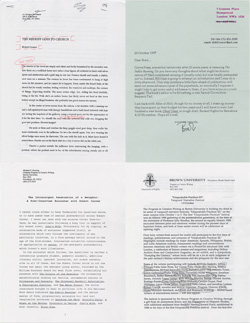 Conjunctions Archive (Bradford Morrow, founder and Editor).
Conjunctions Archive (Bradford Morrow, founder and Editor).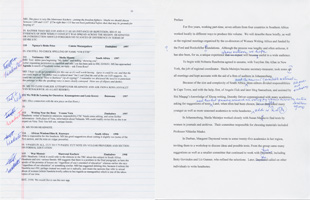 Feminist Press Archive (Florence Howe, founder and President Emerita).
Feminist Press Archive (Florence Howe, founder and President Emerita).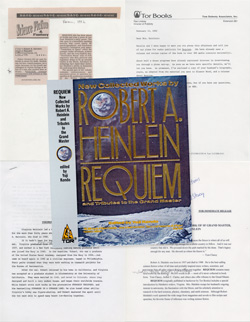 St. Martin's Press Archive (Thomas McCormack and Roy Gainsburg, founders).
St. Martin's Press Archive (Thomas McCormack and Roy Gainsburg, founders).Building upon a modest initiative begun during the previous decade, in the 1990s Special Collections embarked upon a concerted effort to document the American publishing industry, especially during the latter half of the 20th century and beyond. The consequence was a group of collections that provided insight into a wide array of American publishing ventures, from the small independent press to the large multi-national corporation. Over 20 small and fine press archives have been acquired to date, mostly by purchase. These archives document both the literary creative process and the production and business of publishing the work of many of the authors already heavily represented in the John Hay’s book collections, notably the Harris Collection of American Poetry and Plays; examples include Unicorn Press, December Press, Vagabond Press, Greenhouse Review Press, West Coast Poetry Review, and Burning Deck Press, operated by Brown Professors Keith Waldrop and Rosmarie Waldrop. Similarly, the 1996 purchase of the archive of Conjunctions, the literary semi-annual founded by Bradford Morrow in 1981, offers an unrivalled resource that illuminates the publishing milieu of many of the nation’s most innovative writers of contemporary prose and poetry, many of them Brown faculty or alumni/ae. Also in 1996, with assistance from President Vartan Gregorian, the John Hay purchased the archive of the Feminist Press and its founder, Florence Howe. Established in 1970, the Feminist Press is a pioneer in the reissue of long out of print writing by women as well as being a leading publisher of new scholarly and popular writing by women around the globe. Finally, 1996 was the year in which the John Hay received, by corporate donation, the archive of St. Martin’s Press, founded in 1952 by Brown alumni Thomas McCormack and Roy Gainsburg, graduates of the Class of 1954. The St. Martin’s archive sheds light on a large-scale corporate publishing house whose production ranges from scholarly monographs and textbooks to popular genre fiction. Taken together, the publishing archives at Brown provide an unequalled opportunity to study the world of print as it confronts new electronic modes of communication.
While continuing to devote attention to the established literary canon, during the 1990s Special Collections also turned its attention to several areas of popular and special interest literature, particularly in light of increased interest shown by scholars in such genres as fantasy and science fiction, children’s literature, the literature of wit and humor, gay and lesbian literature, and comic books.
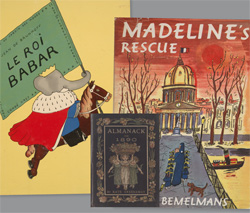 Kate Greenaway, Almanack (London: G. Routledge, [1890]);
Kate Greenaway, Almanack (London: G. Routledge, [1890]); Arlene M. Pillar Collection. The 3,000 volume Pillar Collection focuses primarily on American children's books of the mid-20th century and includes many nominees for the prestigious Caldecott and Newbery awards for excellence in children's literature. Shown here is a selection of titles that were awarded the Caldecott Award for illustration between 1966 and 1988. Arlene M. Pillar Collection. Gift of Russell I. Pillar, Class of 1987 and Matthew G. Pillar, Class of 1990.
Arlene M. Pillar Collection. The 3,000 volume Pillar Collection focuses primarily on American children's books of the mid-20th century and includes many nominees for the prestigious Caldecott and Newbery awards for excellence in children's literature. Shown here is a selection of titles that were awarded the Caldecott Award for illustration between 1966 and 1988. Arlene M. Pillar Collection. Gift of Russell I. Pillar, Class of 1987 and Matthew G. Pillar, Class of 1990.
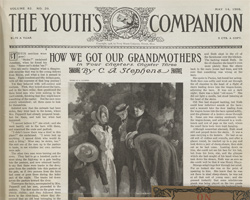 C. A. Stephens Collection. The Youth's Companion was a major family-oriented magazine published in Boston for over 100 years. Its authors included eminent writers of the day, including Mark Twain, Jack London, and Sarah Orne Jewett. Among the most popular and prolific was C. A. Stephens, who contributed some 1,500 stories over of period of almost six decades. Stephens also wrote adventure books for boys that went through numerous editions. Shown here is a Stephens serialized story from 1908 along with books dating from between 1872 and 1900. C. A. Stephens Collection. Bequest of Louise Harris, Class of 1926.
C. A. Stephens Collection. The Youth's Companion was a major family-oriented magazine published in Boston for over 100 years. Its authors included eminent writers of the day, including Mark Twain, Jack London, and Sarah Orne Jewett. Among the most popular and prolific was C. A. Stephens, who contributed some 1,500 stories over of period of almost six decades. Stephens also wrote adventure books for boys that went through numerous editions. Shown here is a Stephens serialized story from 1908 along with books dating from between 1872 and 1900. C. A. Stephens Collection. Bequest of Louise Harris, Class of 1926.
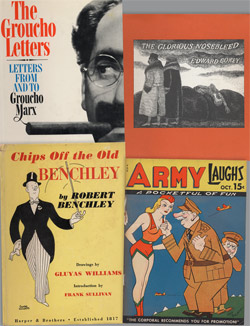 Miller Collection of Wit and Humor. The Miller Collection of Wit and Humor is, at 40,000 volumes, the largest research collection in its field. Although often ephemeral or transitory in its topicality, humor writing provides valuable insights into virtually every aspect of the human condition as well as commentary on contemporary events. Displayed here are titles by famous humorists, past and present, as well as an army joke book published in 1941. Miller Collection of Wit and Humor. Gift of Bernard and Saul Miller.
Miller Collection of Wit and Humor. The Miller Collection of Wit and Humor is, at 40,000 volumes, the largest research collection in its field. Although often ephemeral or transitory in its topicality, humor writing provides valuable insights into virtually every aspect of the human condition as well as commentary on contemporary events. Displayed here are titles by famous humorists, past and present, as well as an army joke book published in 1941. Miller Collection of Wit and Humor. Gift of Bernard and Saul Miller.
The vast field of children’s literature had never been an area of deep concentration at Brown, but good representative holdings were subsumed within numerous collections devoted to other subjects, for example, Clement Clark Moore’s “A Visit from St. Nicholas” and “Mother Goose” in the Harris Collection. Three discrete children’s literature collections were added during the 1990s in an attempt to selectively broaden the scope of the library’s holdings of children’s literature. The first of these was the Lucy Truman Aldrich Collection, donated by Aldrich’s nephew David Rockefeller in 1990. Rich in illustrated classic stories by authors such as Kate Greenaway and Arthur Rackham, the Aldrich Collection is a significant enhancement to the library’s book arts collections as well as providing important editions of such classics as Randolph Caldecott’s Picture Book (London, 1879), Kate Douglas Wiggins’s Rebecca of Sunnybrook Farm (New York, 1903), and Jean de Brunhoff’s Le Roi Babar (Paris, 1933). Similarly important, but with books of a later date, is the 3,000 volume Arlene M. Pillar Collection of children’s books donated by her sons, Russell, Class of 1987, and Matthew, Class of 1990. Many of the books in the Pillar Collection were nominees or winners of the Caldecott and Newbery prizes for excellence in the field of children’s literature. The third collection, bequeathed by Louise Harris, Class of 1926, was a comprehensive collection devoted to C. A. Stephens, a prolific author of boy’s adventure stories that appeared for decades in the popular Youth’s Companion and in a series of books published in the late 19th and early 20th centuries. The Stephens Collection contains virtually every issue of The Youth’s Companion, from its inception in 1827 to its demise in 1929, as well as dozens of editions and variant printings of Stephens’s novels and collected stories.
The literature of wit and humor was another genre new to the John Hay in the 1990s. In 1993, brothers Bernard and Saul Miller gave to Brown their 40,000 volume library, a collection devoted exclusively to humorous writing, primarily American of the 19th and 20th centuries. Every conceivable topic is included in the collection, with subjects ranging from medicine and law to sports, politics, religion, and of course, sex. Ethnic humor, political cartoons, comic novels, cartoon books, army joke books from World War II, even vaudeville routines are to be found in the Miller Collection. Among the thousands of authors are such major figures as Petroleum V. Nasby, Joel Chandler Harris, Groucho Marx, Ogden Nash, Charles Schulz, and Gary Trudeau.
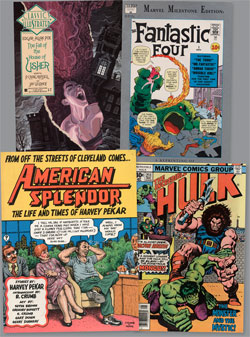 Michael J. Ciaraldi Collection. The comic books collections at the John Hay Library provide remarkable insight into one of the most pervasive forms of recent popular culture. They also complement numerous other collecting areas in Special Collections, from the book arts to literary genres, even historical collections. The variety of comics available is exemplified by the examples displayed here: Poe's The Fall of the House of Usher, adapted by P. Craig Russell and Jay Geldof; Harvey Pekar and R. Crumb's American Splendor; and The Incredible Hulk and The Fantastic Four, both of which were subsequently adapted for film. Michael J. Ciaraldi Collection: Gift of Michael J. Ciaraldi.
Michael J. Ciaraldi Collection. The comic books collections at the John Hay Library provide remarkable insight into one of the most pervasive forms of recent popular culture. They also complement numerous other collecting areas in Special Collections, from the book arts to literary genres, even historical collections. The variety of comics available is exemplified by the examples displayed here: Poe's The Fall of the House of Usher, adapted by P. Craig Russell and Jay Geldof; Harvey Pekar and R. Crumb's American Splendor; and The Incredible Hulk and The Fantastic Four, both of which were subsequently adapted for film. Michael J. Ciaraldi Collection: Gift of Michael J. Ciaraldi.
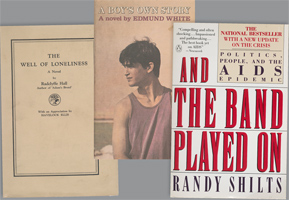 Radclyffe Hall, The Well of Loneliness (London: Jonathan Cape, 1928).
Radclyffe Hall, The Well of Loneliness (London: Jonathan Cape, 1928).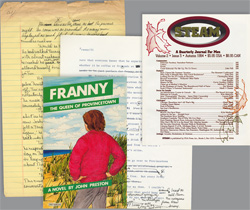 John Preston Papers; Scott O'Hara Papers. In addition to published works, the gay and lesbian collections of the John Hay Library include archival files and the papers of individual authors of note, among them John Preston and Scott O'Hara. Both maintained extensive correspondence with other authors and activists and together their papers provide material for extensive research in the gay and lesbian literary world of the 1970s into the 1990s. Shown here is Preston's popular Franny, the Queen of Provincetown, including drafts, and an issue of Scott O'Hara's underground magazine Steam. Manuscripts Collection. John Preston Papers. Gift and Bequest of John Preston. Scott O'Hara Papers. Bequest of Scott O'Hara.
John Preston Papers; Scott O'Hara Papers. In addition to published works, the gay and lesbian collections of the John Hay Library include archival files and the papers of individual authors of note, among them John Preston and Scott O'Hara. Both maintained extensive correspondence with other authors and activists and together their papers provide material for extensive research in the gay and lesbian literary world of the 1970s into the 1990s. Shown here is Preston's popular Franny, the Queen of Provincetown, including drafts, and an issue of Scott O'Hara's underground magazine Steam. Manuscripts Collection. John Preston Papers. Gift and Bequest of John Preston. Scott O'Hara Papers. Bequest of Scott O'Hara.
Shortly after the arrival of the Miller Collection, the John Hay received a complete run of Valiant Comics, presented by Valiant publisher Steven M. Massarsky, Class of 1970. Thus began what for the time was an unusual collecting area for the John Hay, given both the format and content of comic books. However, shortly after it received the Valiant Collection, Professor Barton Levi St. Armand gave the library the Wayne D. Poulin Collection totaling some 10,000 superhero comics from the 1970s and 1980s. In 1997, these collections were joined by the Michael J. Ciaraldi Collection of over 60,000 comics and illustrated novels, with special strengths in comics issued by small and independent publishers from the 1970s and 1980s. Constituting one of the largest collections of its kind in the country, Brown’s holdings of comics not only offer a remarkable snapshot of a major popular culture phenomenon, they also serve as a sometimes surprising link among other literary, graphic, and popular culture collections in the John Hay, collections as diverse as the Smith Magic Collection, the McLellan Lincoln Collection, the H. P. Lovecraft Collection, and the Anne S. K. Brown Military Collection.
Gay and lesbian literature had been incorporated into other John Hay Library collections for many years, prime examples being gay poetry and plays accumulated through the Harris Collection’s policy of comprehensiveness. Building upon this existing strength, and in recognition of the growing public prominence of the gay and lesbian presence throughout society, a decision was made early in the 1990s to collect prose writing by and about the homosexual experience. The focus was primarily literary in nature but it extended to published, manuscript, and archival material that documented the changing status of the gay and lesbian community, from the AIDS crisis to such contentious issues as gay marriage and gays in the military. The Richard G. Katzoff Collection, donated by his family in 1991, served as the catalyst for future acquisitions, most of them by gift or bequest. Substantial donations of books were received throughout the decade, highlights being the James Jackson Collection, a continuing gift from A. Christian Fredrick, and more recently, a sizeable collection given by Ronald L. Smith. A large collection of gay pulp paperback novels was acquired in 1996, adding a new facet to the library’s genre literature holdings. Complementary collections arriving in the 1990s included the archives of On Our Backs, a Lesbian-oriented magazine, donated by Melissa Murphy, Class of 1990, and the files of authors John Preston and Scott O’Hara, whose extensive correspondence provided unique perspectives on gay political and social activism as well as gay literature. These have been joined by additional author archives, examples being the papers of Michael Lowenthal, Rudy Kikel, Danny Sotomayor, Barbara Deming, and John C. Russell, MFA Class of 1991.
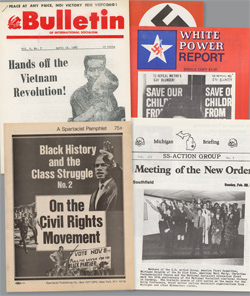 The Hall-Hoag Collection consists of over 300,000 items documenting dissenting and extremist movements in the United States, primarily between 1950 and 2000. Gordon Hall, who assembled the collection with the assistance of Grace Hoag, gave equal weight to left- and right-wing viewpoints on every controversial subject confronted by American society in the post World War II–pre-9/11 era, from McCarthyism to Vietnam to the women's movement and civil rights. Hall-Hoag Collection of Extremist and Dissenting Printed Propaganda.
The Hall-Hoag Collection consists of over 300,000 items documenting dissenting and extremist movements in the United States, primarily between 1950 and 2000. Gordon Hall, who assembled the collection with the assistance of Grace Hoag, gave equal weight to left- and right-wing viewpoints on every controversial subject confronted by American society in the post World War II–pre-9/11 era, from McCarthyism to Vietnam to the women's movement and civil rights. Hall-Hoag Collection of Extremist and Dissenting Printed Propaganda.
As the scope of the John Hay’s literature collections expanded in the 1990s, so too did the focus of American history. At the turn of the decade the library purchased, over a period of years, the 300,000-piece Hall-Hoag Collection of Dissenting and Extremist Printed Propaganda. Begun by Gordon Hall just after World War II, the collection gave equal attention to right-wing and left-wing movements from the time of McCarthy through the civil rights movement to Vietnam and such social movements as feminism and gay rights. Hall, joined in his collecting activities by Grace Hoag in the 1960s, amassed a collection that has no equal in terms of its size and in the breadth of its scope. Regardless of the topic or the nature of the dissenting movement, researchers will find resources that are often unobtainable elsewhere and certainly not in the sheer volume in which they are present at Brown. The American Communist Party, the Lyndon LaRouche organization, pro- and anti-abortion groups, the Ku Klux Klan, religious cults, neo-Nazi groups, all are represented in depth. Subsequent to its arrival at Brown, the Hall-Hoag Collection has attracted gifts of complementary materials, including left-wing documents donated by the Lucy Parsons Center and a large body of records from the John Birch Society, donated by Political Research Associates.
The rapid expansion of Special Collections in the 1990s, combined with the large size of several of the collections acquired, resulted in the need for additional space. This fact, combined with the simultaneous growth of the Brown Library’s circulating collections in the Rockefeller and Sciences Libraries, led to the decision in 1996 to store certain materials off-site. Preservation and retrieval issues required a custom-designed facility and the Brown Library thus rented space for several years at the Harvard Depository Library. A far better solution was the construction, in 2005, of Brown’s own atmospherically and technologically sophisticated Library Annex, located off-campus but within a short driving distance from the libraries. The capacity of the Annex is the equivalent of 1,500,000 volumes and an additional advantage is that the structure is modular with sufficient land for future expansion at a relatively low cost.
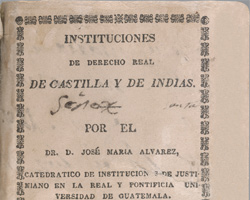 José María Alvarez, Instituciones de Derecho Real de Castilla y de Indias ([Taos: Antonio José Martínez, Jesús María Baca], 1842).
José María Alvarez, Instituciones de Derecho Real de Castilla y de Indias ([Taos: Antonio José Martínez, Jesús María Baca], 1842). John Babington, frontispiece and title page from Pyrotechnia or, A Discourse of Artificiall Fire-Works (London: Printed by Thomas Harper for Ralph Mab, 1635).
John Babington, frontispiece and title page from Pyrotechnia or, A Discourse of Artificiall Fire-Works (London: Printed by Thomas Harper for Ralph Mab, 1635).The pace of collection growth was such that the library system reached the milestone of 3,000,000 volumes in 1996, just 12 years after the acquisition of its 2,000,000th volume. In recognition of the University’s growing global status, and the library’s role in the University’s expanded curricular and research endeavors, three diverse collections were chosen to celebrate the 3,000,000th acquisition, all funded with a gift from Paul R. Dupee, Jr., Class of 1965. The Dupee Mexicana Collection commemorated Brown’s position internationally, the Dupee Digital Reference Collection acknowledged the evolution of library resources into the electronic age, and the Dupee Fireworks Collection celebrated the centrality of traditional rare books and special collections as vital to research in the humanities. The iconic item chosen as the 3,000,000th volume was John Babington’s Pyrotechnia (London, 1635), the first book in English devoted to the subject of fireworks for pleasure.